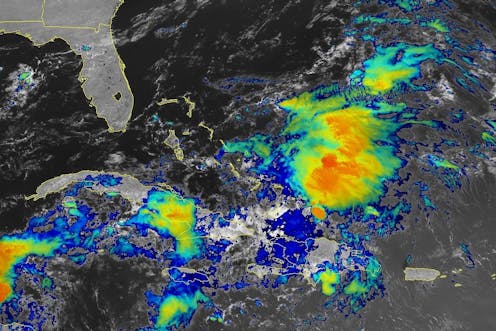Birth of a hurricane: What meteorologists look for as they hunt for early signs of a tropical cyclon
Forecasters are closely watching a storm headed for the Caribbean that’s likely to become Ernesto. New techniques are helping them spot potentially dangerous storms earlier than ever.

When tropical meteorologists peer at satellite images, they often catch sight of subtle cloud formations hinting at something more ominous brewing.
The first signs of a potential hurricane can be detected days before a storm gains its fierce momentum. Wispy cirrus clouds radiating outward, the appearance of curved banding low-level clouds and a drop in atmospheric pressure are all clues.
These early clues are crucial for predicting the onset of what might develop into a catastrophic hurricane.
I am a meteorology professor at Penn State, and my research group uses satellites and computer models to improve forecasting of tropical weather systems. With an especially fierce Atlantic storm season forecast for 2024, being able to detect these initial signals and provide early warnings is more important than ever. Here’s what forecasters look for.
Conditions ripe for a hurricane
Hurricanes typically start as atmospheric tropical waves, areas of low pressure associated with clusters of thunderstorms. As these tropical waves move westward across tropical oceans, some of them can develop into hurricanes.
The formation of a hurricane hinges on several specific conditions:
Distance from the Equator: Tropical cyclones usually form at least 5 degrees from the equator. This is because the Coriolis force, crucial for the initial spin-up of the cyclonic system, is weaker near the equator. The Coriolis force is caused by the Earth’s rotation, which makes moving air turn and swirl.
Warm sea surface temperatures: The sea surface temperature must be at least 26.5 degrees Celsius (about 80 Fahrenheit) for a hurricane to form. The warm water provides energy that drives the storm as the storm absorbs heat and moisture from the ocean.
Atmospheric instability and moisture: For tropical cyclones to form, the atmosphere needs to be unstable. This means that warm surface air rises and remains warmer than the surrounding air, allowing it to keep rising and forming thunderstorms. There also needs to be plenty of moisture, as dry air can cause clouds to evaporate and weaken the upward motions within thunderstorms. These factors are essential for the development of clustered thunderstorms within the tropical waves.
Low vertical wind shear: Strong vertical wind shear can tear a developing hurricane apart. Vertical wind shear is changes in wind direction or speed at different elevations. It disrupts a storm’s formation and growth and makes it hard for a hurricane to keep its vortex aligned.
Early forecasting requires more than satellites
Recognizing the early stages in the life cycle of a hurricane has been very challenging because there aren’t large numbers of surface stations and weather balloons to provide detailed atmospheric information over the open ocean.
Once a storm starts to form, the National Oceanic and Atmospheric Administration’s hurricane hunter airplanes will often fly through it, taking measurements and dropping sensors to get more data. But that can’t happen for every wispy cloud, particularly when the developing system is far from the coast.
One of the primary tools meteorologists currently use to forecast the early formation of hurricanes is satellite imagery, which provides real-time data on cloud patterns, sea surface temperatures and other atmospheric conditions. For instance, the GOES satellites operated by NOAA help meteorologists track the development of hurricanes with unprecedented clarity. These satellites can capture images at multiple wavelengths, allowing forecasters to analyze various aspects of the storm, such as cloud formation, precipitation and lightning activity.

However, satellite observations alone don’t provide enough information for meteorologists to know which tropical waves are likely to develop into hurricanes.
To enhance forecasting accuracy, our research group has developed methods for incorporating real-time satellite data, including humidity levels and cloud patterns, into computer forecast models. This process, known as data assimilation, enables a more precise and consistent depiction of atmospheric conditions. As a result, forecasters can benefit from significantly enhanced predictive capabilities, particularly in anticipating the formation and progression of hurricanes.
We’re currently working with NOAA to refine these techniques and bring them into wider use for better hurricane forecasting and earlier warnings so the public has more time to prepare.
As people in North America and the Caribbean brace for what is predicted to be a particularly intense hurricane season in 2024, the need for accurate early storm forecasting has never been greater.
Xingchao Chen receives funding from NOAA, DOE, NASA and ONR.
Read These Next
What’s at stake in Trump’s executive order aiming to curb state-level AI regulation
In the absence of comprehensive federal AI regulation, states have stepped in. The Trump administration,…
The Bible says little about Jesus’ childhood – but that didn’t stop medieval Christians from enjoyin
Legends about Jesus’ early years that circulated in medieval Europe often drew on apocryphal texts.
Sleep problems and depression can be a vicious cycle, especially during pregnancy − here’s why it’s
Inadequate sleep can have negative downstream effects on everyday cognitive functioning and mental health,…





